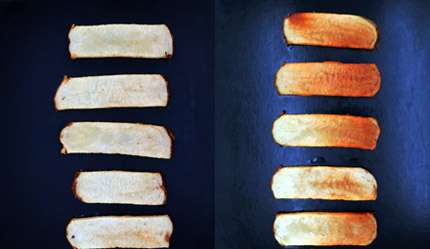Fries with a side of acrylamide: Researchers working to cut unwanted chemical in French fries

French fry lovers, beware! You may be exposed to a chemical more commonly associated with heavy industry than crispy fried potatoes. Fortunately, researchers are finding ways to reduce that exposure.
French fries contain acrylamide. The chemical poses a risk for several types of cancer in rodents. However, the evidence from human studies is still incomplete. The International Agency for Research on Cancer considers the chemical a "probable human carcinogen."
Scientists first began paying attention to the unwanted chemical's presence in food more than a decade ago. Trace amounts of acrylamide are present in many foods cooked at temperatures higher than 248 degrees Fahrenheit. Relatively high levels are found in fried potatoes, including French fries and potato chips.
With that in mind, a group of scientists set out in 2011 to identify potato varieties that form less acrylamide.
Led by University of Idaho researcher Yi Wang, the group assessed more than 140 potato varieties. The researchers' goal was to identify potatoes that make great French fries and form less acrylamide. The amount of the chemical found in fried potatoes is thought to be directly linked to the chemistry of the raw potatoes.
Raw potatoes contain an amino acid called asparagine. The amino acid is found in many animal and plant food sources, and it's a known precursor of acrylamide. When cooked at high temperatures, sugars react with amino acids, including asparagine, in a chemical process known as the Maillard reaction. The reaction is what gives fried potatoes their prized flavor and color, but it is also what produces acrylamide.

Researchers planted 149 potato breeds in five potato-growing regions across the United States. Upon harvesting, they sent some of the raw potatoes to labs. There, the potatoes were stored in conditions similar to commercial potatoes. After storage, the labs tested the potatoes for their levels of reducing sugars and asparagine. Researchers then fried some of the potatoes and observed how much acrylamide the potatoes formed.
The researchers found that it is fairly achievable to identify potato breeds that produce less acrylamide, especially when compared with the industry standard potato breeds, Ranger Russet and Russet Burbank.
"The real challenge is to find the varieties that not only have those characteristics, but also yield finished products with desirable processing quality that meet the stringent standards of the food industry," Wang said.

Two of the most promising varieties—Payette Russet and Easton—have already been released for commercial use.
Wang said the group hopes to identify genes that are related to lower acrylamide in certain fried potatoes. The study shows a strong relationship between the genetics of a raw potato and its potential to form acrylamide. If researchers are able to identify the specific genes, they may be able to eliminate them in the future.
The team's research is published in Crop Science.
More information: Yi Wang et al. Acrylamide-Forming Potential and Agronomic Properties of Elite US Potato Germplasm from the National Fry Processing Trial, Crop Science (2015). DOI: 10.2135/cropsci2015.03.0173
Provided by American Society of Agronomy

















